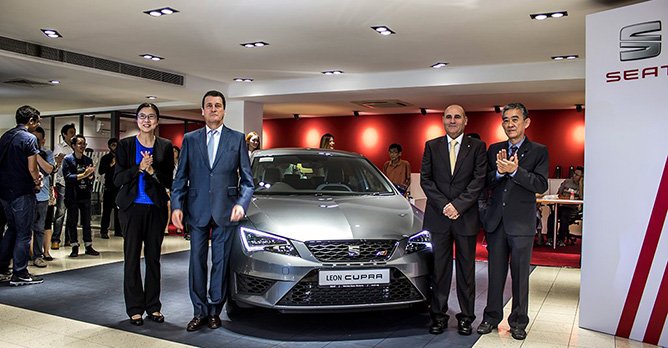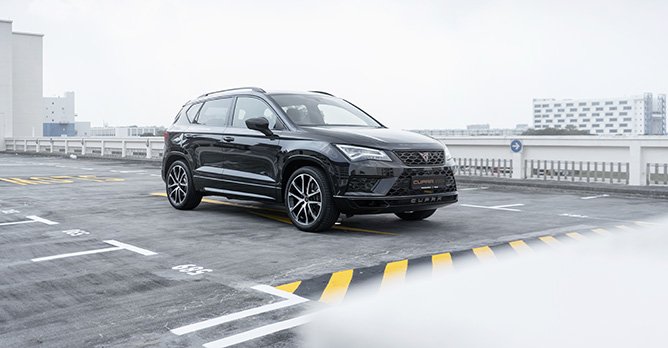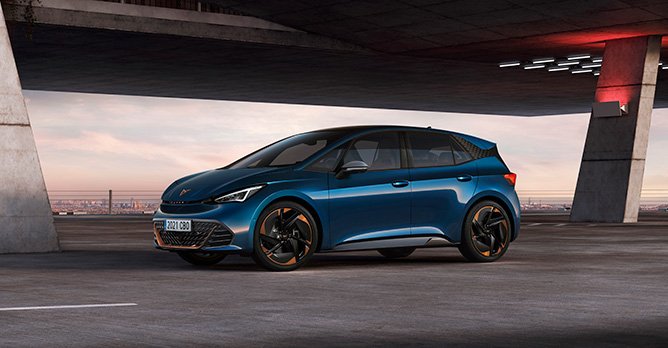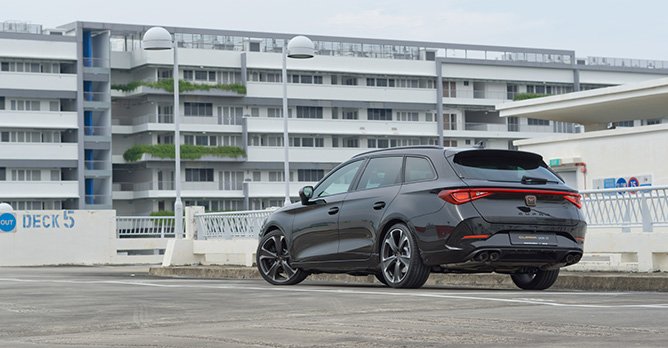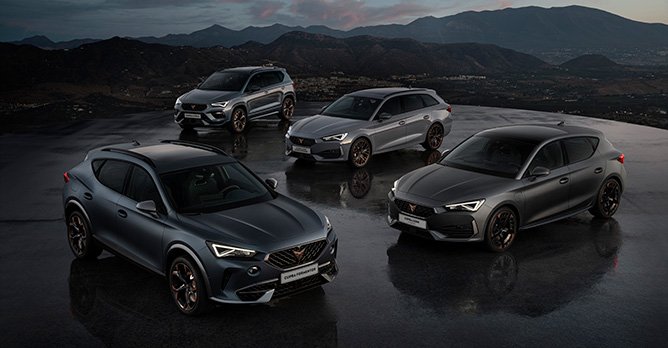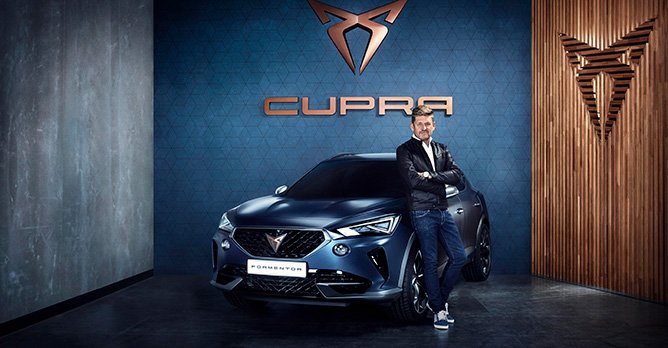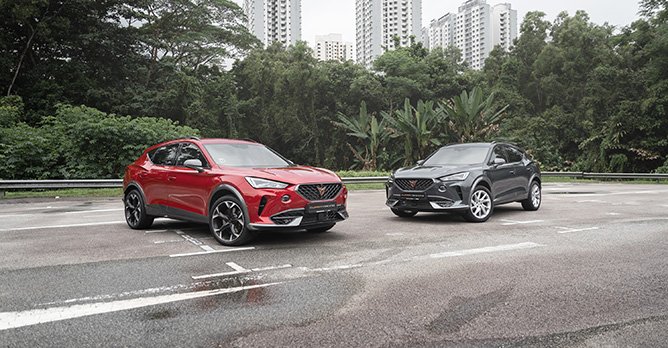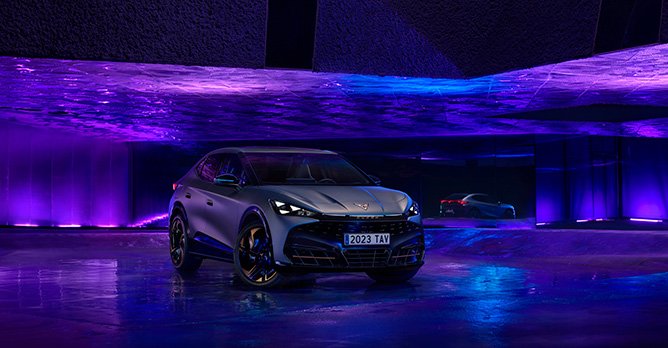Electrification is key: A deeper dive into Volkswagen Group's takeover of Cupra (and not Seat) in Singapore
01 Jun 2023|7,734 views
If Spanish cars have never been your cup of tea (or glass of sangria), the news that broke recently - that Cupra is coming under Volkswagen Group Singapore (VGS), even as the sale of new Seat cars is set to be discontinued - might have been confusing.
So let's start from the beginning.
2016 marked the year that Volkswagen Group-owned Seat made a grand return to Singapore after a long 13 year hiatus. At that point, the 'mass market' brands under the Group were still in vastly different places here; Volkswagen was on its own, while the fate of Skoda was still undecided following the implosion of previous custodian, Harvest Automobiles. As things turned out - in that sort of climate seven years back - the reins for Seat were handed over to dealer Vertex Automobiles.
It's likely even Vertex didn't know, however, that the stage was being set for it to steward two names with this single deal.
Once a simple (but potent) suffix on the back of more manic motorsports-inspired variants of the Seat Leon, 'Cupra' officially branched out into its own independent brand at the dawn of 2018; the gleaming new performance offshoot of Seat.
Soon after, Vertex also helped to launch the first cars from the marque here, including the Cupra Ateca, Cupra Leon and Cupra Leon Sportstourer - all derived from existing Seat models - and the Cupra-only Formentor.
Back to the present
This history, if somewhat long-winded, is key to understanding the surprise some may have felt at the announcement last last week. Without Seat, there couldn't have been Cupra. Why was the child now being retained without its parent?
It turns out the wheels of change in the car industry - both internationally but particularly in Singapore - helped steer things in this direction. When we ask VGS, we learn that the move has been centred since Day One on the same, unavoidable buzzword of today's auto industry.
"A big aspect of our business strategy moving forward is electrification," Kurt Leitner, Managing Director of VGS tells us, apparently in specific reference to the local context. "Cupra's existing lineup and ambition to become a fully electric brand by 2030 complements that. Seat has not released any EVs yet."
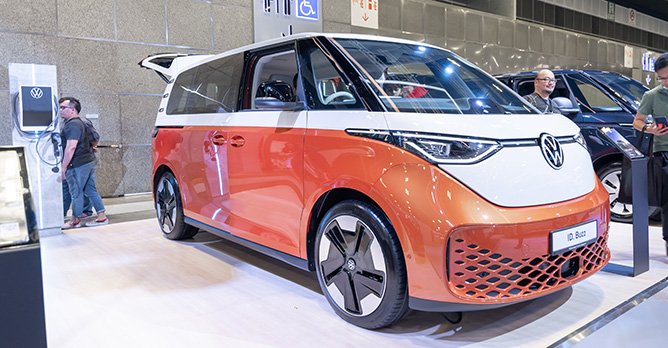
 In tandem with the Singapore government and the larger Group, VGS is also committing to electrification in the coming years The decision, we learn, hasn't just been months, but years in the making - ever since the Singapore government announced the Singapore Green Plan in 2021. Coincidentally, the Plan dictates that all new car and taxi registrations have to be of cleaner-energy models by the same year: 2030.
In tandem with the Singapore government and the larger Group, VGS is also committing to electrification in the coming years The decision, we learn, hasn't just been months, but years in the making - ever since the Singapore government announced the Singapore Green Plan in 2021. Coincidentally, the Plan dictates that all new car and taxi registrations have to be of cleaner-energy models by the same year: 2030.
"Electrification is not just our focus but the Volkswagen Group's," Kurt reminds us. By the end of this decade, the conglomerate is aiming for half of all new car sales across its Infinity Gauntlet of brands to comprise all-electric models.
Bearing in mind that electrification was not just an outlined goal of the Singapore government and the Group -but also always part of the future it saw with Cupra - VGS believes its move to embrace Cupra now is well-timed. (There is no word on a potential Seat return at this juncture.)
Singapore: Outsized taxes in an undersized market
The other part of the equation, naturally, is that of brand consolidation.
The official line is that Seat is technically not departing entirely; VGS has still fully committed to aftersales for existing Seat owners. Regaining control of both Cupra retail and Seat aftersales, we are told, was a joint decision by VGS and its head office, with the former now finally able to "represent the 'volume' brands [of the Group] all under one roof".
VGS cites the knowledge and experience - over 10 years - with representing the volume brands as "a strong base" to continue serving Cupra and Seat owners. In particular, service advisors were retrained on "the Cupra brand experience" in order to "ensure a smooth transition".

 Seat has largely been unable to avoid overlaps with both the VW and Skoda ranges - with the possible exception of the Leon Sportstourer In the meantime, VGS has built up a sizable inventory of parts for customers. "For example, in the event of an accident, we are already fully equipped to repair and replace any necessary part," Kurt tells us.
Seat has largely been unable to avoid overlaps with both the VW and Skoda ranges - with the possible exception of the Leon Sportstourer In the meantime, VGS has built up a sizable inventory of parts for customers. "For example, in the event of an accident, we are already fully equipped to repair and replace any necessary part," Kurt tells us.
But taking a step back also sheds light on the difficulties faced with all three ostensibly 'mass market'-oriented brands fighting for similarly-heeled customers, in a simultaneously tax-heavy and miniscule market like Singapore's.
If you study them closely, clashes between the Volkswagen and Skoda lineups have been largely deconflicted at this point. In terms of compact cars, for instance, Skoda's Scala and Octavia are quite different from VW’s Polo, T-Cross and Golf.
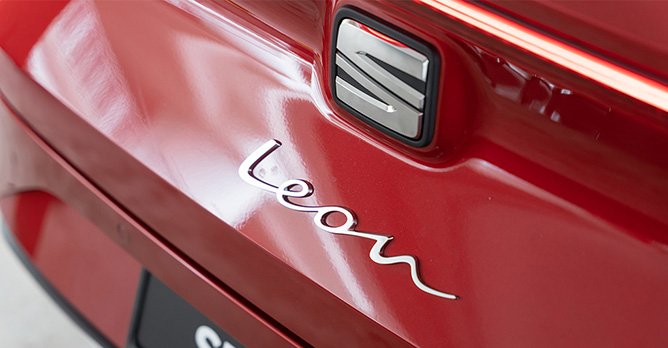
 Often on the losing end of fighting with Skoda and VW for local customers, Seat's models have traditionally found less favour in the market But Seat, especially with its lower brand recognition, has suffered (the Seat Leon directly battles the legendary Golf; the Tarraco is up against the Kodiaq).
Often on the losing end of fighting with Skoda and VW for local customers, Seat's models have traditionally found less favour in the market But Seat, especially with its lower brand recognition, has suffered (the Seat Leon directly battles the legendary Golf; the Tarraco is up against the Kodiaq).
The Spanish marque's best year on record was in 2019, when it registered 329 units. Its second and third best performances were in the years after and before - 248 units in 2020 (when the Cupra brand officially landed), and 216 units in 2018.
Even so, it has been consistently outpaced by Skoda, which registered 849 and 663 units in 2019 and 2020. (Volkswagen itself managed 1,736 in 2019.) The current market slump has made things worse. Last year, just 74 Seats and Cupras were registered - against 175 Skodas, and 452 Volkswagens.
And Cupra: The young, rebellious, future-ready member of the family
That brings us back to the future of Cupra here. Expectedly, VGS is still coy about its concrete blueprint for Singapore. When asked separately about sales targets, the possibility of a new showroom, and how exactly the brand will be marketed here, we are told time and again: "Our retail plans are slated for 2024, more details will be available then."
Nonetheless, cast your line of sight wider out into the world, and one will see that the potential for Cupra’s name and appeal to grow is not to be underestimated.
Against Volkswagen and Skoda, and even its parent Seat, the five-year old brand takes a decidedly different approach.
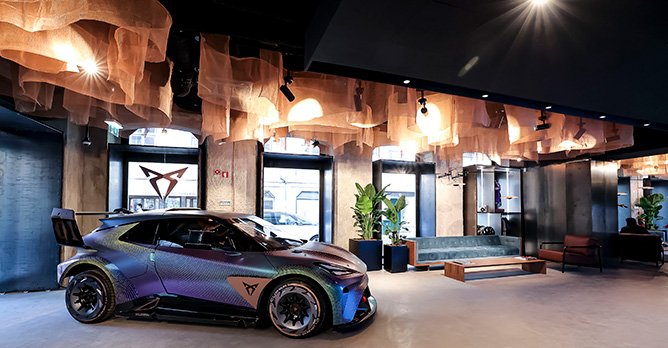
 The international Cupra City Garages rely on a brand-distinct style while infusing parts of local culture Cupras have come to be known for their bolder designs, relying most notably on triangular patterns. In tandem, the aesthetic of new Cupra launches - especially in recent times - can perhaps be best described as 'cyberpunk'; a mish-mash of neon colours and graffiti-inspired text blocks splashed onto dark backdrops. Golden hour is favoured in the press photos of other carmakers. In Cupra-land, dusk is almost always falling.
The international Cupra City Garages rely on a brand-distinct style while infusing parts of local culture Cupras have come to be known for their bolder designs, relying most notably on triangular patterns. In tandem, the aesthetic of new Cupra launches - especially in recent times - can perhaps be best described as 'cyberpunk'; a mish-mash of neon colours and graffiti-inspired text blocks splashed onto dark backdrops. Golden hour is favoured in the press photos of other carmakers. In Cupra-land, dusk is almost always falling.
The unorthodox visuals follow the general tone the brand has tried to set. Its sales ambassadors are called Cupra Masters. Its retail concept stores, Cupra City Garages, infuse bits of local culture no matter where they're set up while holding onto the brand's signature copper-grey palette.
In press photos and on stage, too, it is not starched suits and leather shoes, but bomber jackets, jeans and sneakers that Cupra's (also Seat's) CEO, Wayne Griffiths, is decked out in. "Hi Cupra Tribe!", is how he starts out a LinkedIn post - the term ostensibly referring not just to employees but everyday fans of the performance marque.
"Of course, we aim to be aligned with the rest of the Cupra markets", Kurt tells us, while reiterating the 2024 timeline. Still, "[in] terms of marketing and brand positioning, Cupra will definitely stand out with its provocative and edgy nature."
We question whether the prohibitive pricing of Singapore's car market fundamentally constricts Cupra's ability to reach an intentionally younger target audience. But VGS seems to know that its efforts cannot be directed solely (nor immediately) to selling cars.
"Even if younger car enthusiasts are not able to purchase a Cupra just yet, we want to build aspiration, love and a following for the brand," Kurt states. VGS also wants to "leverage their passion to influence others who may be considering something unconventional, disruptive, and inspiring."
To come back to Cupra's 2030 full electrification goal, 2024 is the target VGS has outlined to introduce the Born, Cupra's first all-electric model built on the MEB platform, to Singapore. Should no delays come to pass, Cupra would actually not be too far behind Skoda and Volkswagen in officially launching an all-electric car here; the ID. 4, ID. Buzz and Enyaq Coupe iV have all been previewed, but are still not for sale yet.
And even after the Born, Cupra has more confirmed all-electric firepower waiting yet: The Tavascan, a coupe-SUV, will go into production in 2024, and the Raval (previously UrbanRebel), a hatchback Cupra is insisting on specifically calling an "urban car", will follow in 2025.
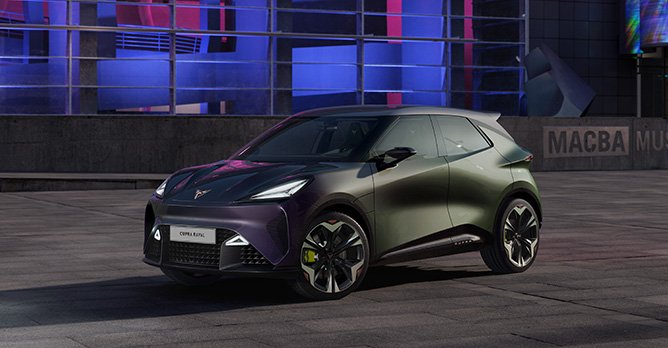
 If they haven't yet, Spanish cars may just become your cup of the tea in the years to come (Raval pictured) What this means is that things are chugging along just as planned for the larger, greener future envisioned by VGS is envisioning locally.
If they haven't yet, Spanish cars may just become your cup of the tea in the years to come (Raval pictured) What this means is that things are chugging along just as planned for the larger, greener future envisioned by VGS is envisioning locally.
"Our focus now is to grow the Cupra brand and the Volkswagen and Skoda electrified portfolio for our customers," Kurt replies to a question regarding any renewed targets for the company's local presence with the new addition to the family. In the years to come, don't be surprised to find your palette changing, and Spanish cars slowly becoming your cup of tea.
Here are a few other stories that may interest you!
Our resident editors from Sgcarmart and Torque battle out with the Cupra Formentor
The long way from Singapore to Desaru with Cat A Volkswagens and Skodas
Our Editors go head on about the colours of the all new Skoda Octavia RS
So let's start from the beginning.
2016 marked the year that Volkswagen Group-owned Seat made a grand return to Singapore after a long 13 year hiatus. At that point, the 'mass market' brands under the Group were still in vastly different places here; Volkswagen was on its own, while the fate of Skoda was still undecided following the implosion of previous custodian, Harvest Automobiles. As things turned out - in that sort of climate seven years back - the reins for Seat were handed over to dealer Vertex Automobiles.
It's likely even Vertex didn't know, however, that the stage was being set for it to steward two names with this single deal.
Once a simple (but potent) suffix on the back of more manic motorsports-inspired variants of the Seat Leon, 'Cupra' officially branched out into its own independent brand at the dawn of 2018; the gleaming new performance offshoot of Seat.
Soon after, Vertex also helped to launch the first cars from the marque here, including the Cupra Ateca, Cupra Leon and Cupra Leon Sportstourer - all derived from existing Seat models - and the Cupra-only Formentor.
Back to the present
This history, if somewhat long-winded, is key to understanding the surprise some may have felt at the announcement last last week. Without Seat, there couldn't have been Cupra. Why was the child now being retained without its parent?
It turns out the wheels of change in the car industry - both internationally but particularly in Singapore - helped steer things in this direction. When we ask VGS, we learn that the move has been centred since Day One on the same, unavoidable buzzword of today's auto industry.
"A big aspect of our business strategy moving forward is electrification," Kurt Leitner, Managing Director of VGS tells us, apparently in specific reference to the local context. "Cupra's existing lineup and ambition to become a fully electric brand by 2030 complements that. Seat has not released any EVs yet."

"Electrification is not just our focus but the Volkswagen Group's," Kurt reminds us. By the end of this decade, the conglomerate is aiming for half of all new car sales across its Infinity Gauntlet of brands to comprise all-electric models.
Bearing in mind that electrification was not just an outlined goal of the Singapore government and the Group -but also always part of the future it saw with Cupra - VGS believes its move to embrace Cupra now is well-timed. (There is no word on a potential Seat return at this juncture.)
Singapore: Outsized taxes in an undersized market
The other part of the equation, naturally, is that of brand consolidation.
The official line is that Seat is technically not departing entirely; VGS has still fully committed to aftersales for existing Seat owners. Regaining control of both Cupra retail and Seat aftersales, we are told, was a joint decision by VGS and its head office, with the former now finally able to "represent the 'volume' brands [of the Group] all under one roof".
VGS cites the knowledge and experience - over 10 years - with representing the volume brands as "a strong base" to continue serving Cupra and Seat owners. In particular, service advisors were retrained on "the Cupra brand experience" in order to "ensure a smooth transition".

But taking a step back also sheds light on the difficulties faced with all three ostensibly 'mass market'-oriented brands fighting for similarly-heeled customers, in a simultaneously tax-heavy and miniscule market like Singapore's.
If you study them closely, clashes between the Volkswagen and Skoda lineups have been largely deconflicted at this point. In terms of compact cars, for instance, Skoda's Scala and Octavia are quite different from VW’s Polo, T-Cross and Golf.

The Spanish marque's best year on record was in 2019, when it registered 329 units. Its second and third best performances were in the years after and before - 248 units in 2020 (when the Cupra brand officially landed), and 216 units in 2018.
Even so, it has been consistently outpaced by Skoda, which registered 849 and 663 units in 2019 and 2020. (Volkswagen itself managed 1,736 in 2019.) The current market slump has made things worse. Last year, just 74 Seats and Cupras were registered - against 175 Skodas, and 452 Volkswagens.
And Cupra: The young, rebellious, future-ready member of the family
That brings us back to the future of Cupra here. Expectedly, VGS is still coy about its concrete blueprint for Singapore. When asked separately about sales targets, the possibility of a new showroom, and how exactly the brand will be marketed here, we are told time and again: "Our retail plans are slated for 2024, more details will be available then."
Nonetheless, cast your line of sight wider out into the world, and one will see that the potential for Cupra’s name and appeal to grow is not to be underestimated.
Against Volkswagen and Skoda, and even its parent Seat, the five-year old brand takes a decidedly different approach.

The unorthodox visuals follow the general tone the brand has tried to set. Its sales ambassadors are called Cupra Masters. Its retail concept stores, Cupra City Garages, infuse bits of local culture no matter where they're set up while holding onto the brand's signature copper-grey palette.
In press photos and on stage, too, it is not starched suits and leather shoes, but bomber jackets, jeans and sneakers that Cupra's (also Seat's) CEO, Wayne Griffiths, is decked out in. "Hi Cupra Tribe!", is how he starts out a LinkedIn post - the term ostensibly referring not just to employees but everyday fans of the performance marque.
"Of course, we aim to be aligned with the rest of the Cupra markets", Kurt tells us, while reiterating the 2024 timeline. Still, "[in] terms of marketing and brand positioning, Cupra will definitely stand out with its provocative and edgy nature."
We question whether the prohibitive pricing of Singapore's car market fundamentally constricts Cupra's ability to reach an intentionally younger target audience. But VGS seems to know that its efforts cannot be directed solely (nor immediately) to selling cars.
"Even if younger car enthusiasts are not able to purchase a Cupra just yet, we want to build aspiration, love and a following for the brand," Kurt states. VGS also wants to "leverage their passion to influence others who may be considering something unconventional, disruptive, and inspiring."
To come back to Cupra's 2030 full electrification goal, 2024 is the target VGS has outlined to introduce the Born, Cupra's first all-electric model built on the MEB platform, to Singapore. Should no delays come to pass, Cupra would actually not be too far behind Skoda and Volkswagen in officially launching an all-electric car here; the ID. 4, ID. Buzz and Enyaq Coupe iV have all been previewed, but are still not for sale yet.
And even after the Born, Cupra has more confirmed all-electric firepower waiting yet: The Tavascan, a coupe-SUV, will go into production in 2024, and the Raval (previously UrbanRebel), a hatchback Cupra is insisting on specifically calling an "urban car", will follow in 2025.

"Our focus now is to grow the Cupra brand and the Volkswagen and Skoda electrified portfolio for our customers," Kurt replies to a question regarding any renewed targets for the company's local presence with the new addition to the family. In the years to come, don't be surprised to find your palette changing, and Spanish cars slowly becoming your cup of tea.
Here are a few other stories that may interest you!
Our resident editors from Sgcarmart and Torque battle out with the Cupra Formentor
The long way from Singapore to Desaru with Cat A Volkswagens and Skodas
Our Editors go head on about the colours of the all new Skoda Octavia RS
If Spanish cars have never been your cup of tea (or glass of sangria), the news that broke recently - that Cupra is coming under Volkswagen Group Singapore (VGS), even as the sale of new Seat cars is set to be discontinued - might have been confusing.
So let's start from the beginning.
2016 marked the year that Volkswagen Group-owned Seat made a grand return to Singapore after a long 13 year hiatus. At that point, the 'mass market' brands under the Group were still in vastly different places here; Volkswagen was on its own, while the fate of Skoda was still undecided following the implosion of previous custodian, Harvest Automobiles. As things turned out - in that sort of climate seven years back - the reins for Seat were handed over to dealer Vertex Automobiles.
It's likely even Vertex didn't know, however, that the stage was being set for it to steward two names with this single deal.
Once a simple (but potent) suffix on the back of more manic motorsports-inspired variants of the Seat Leon, 'Cupra' officially branched out into its own independent brand at the dawn of 2018; the gleaming new performance offshoot of Seat.
Soon after, Vertex also helped to launch the first cars from the marque here, including the Cupra Ateca, Cupra Leon and Cupra Leon Sportstourer - all derived from existing Seat models - and the Cupra-only Formentor.
Back to the present
This history, if somewhat long-winded, is key to understanding the surprise some may have felt at the announcement last last week. Without Seat, there couldn't have been Cupra. Why was the child now being retained without its parent?
It turns out the wheels of change in the car industry - both internationally but particularly in Singapore - helped steer things in this direction. When we ask VGS, we learn that the move has been centred since Day One on the same, unavoidable buzzword of today's auto industry.
"A big aspect of our business strategy moving forward is electrification," Kurt Leitner, Managing Director of VGS tells us, apparently in specific reference to the local context. "Cupra's existing lineup and ambition to become a fully electric brand by 2030 complements that. Seat has not released any EVs yet."

 In tandem with the Singapore government and the larger Group, VGS is also committing to electrification in the coming years The decision, we learn, hasn't just been months, but years in the making - ever since the Singapore government announced the Singapore Green Plan in 2021. Coincidentally, the Plan dictates that all new car and taxi registrations have to be of cleaner-energy models by the same year: 2030.
In tandem with the Singapore government and the larger Group, VGS is also committing to electrification in the coming years The decision, we learn, hasn't just been months, but years in the making - ever since the Singapore government announced the Singapore Green Plan in 2021. Coincidentally, the Plan dictates that all new car and taxi registrations have to be of cleaner-energy models by the same year: 2030.
"Electrification is not just our focus but the Volkswagen Group's," Kurt reminds us. By the end of this decade, the conglomerate is aiming for half of all new car sales across its Infinity Gauntlet of brands to comprise all-electric models.
Bearing in mind that electrification was not just an outlined goal of the Singapore government and the Group -but also always part of the future it saw with Cupra - VGS believes its move to embrace Cupra now is well-timed. (There is no word on a potential Seat return at this juncture.)
Singapore: Outsized taxes in an undersized market
The other part of the equation, naturally, is that of brand consolidation.
The official line is that Seat is technically not departing entirely; VGS has still fully committed to aftersales for existing Seat owners. Regaining control of both Cupra retail and Seat aftersales, we are told, was a joint decision by VGS and its head office, with the former now finally able to "represent the 'volume' brands [of the Group] all under one roof".
VGS cites the knowledge and experience - over 10 years - with representing the volume brands as "a strong base" to continue serving Cupra and Seat owners. In particular, service advisors were retrained on "the Cupra brand experience" in order to "ensure a smooth transition".

 Seat has largely been unable to avoid overlaps with both the VW and Skoda ranges - with the possible exception of the Leon Sportstourer In the meantime, VGS has built up a sizable inventory of parts for customers. "For example, in the event of an accident, we are already fully equipped to repair and replace any necessary part," Kurt tells us.
Seat has largely been unable to avoid overlaps with both the VW and Skoda ranges - with the possible exception of the Leon Sportstourer In the meantime, VGS has built up a sizable inventory of parts for customers. "For example, in the event of an accident, we are already fully equipped to repair and replace any necessary part," Kurt tells us.
But taking a step back also sheds light on the difficulties faced with all three ostensibly 'mass market'-oriented brands fighting for similarly-heeled customers, in a simultaneously tax-heavy and miniscule market like Singapore's.
If you study them closely, clashes between the Volkswagen and Skoda lineups have been largely deconflicted at this point. In terms of compact cars, for instance, Skoda's Scala and Octavia are quite different from VW’s Polo, T-Cross and Golf.


Often on the losing end of fighting with Skoda and VW for local customers, Seat's models have traditionally found less favour in the market But Seat, especially with its lower brand recognition, has suffered (the Seat Leon directly battles the legendary Golf; the Tarraco is up against the Kodiaq).
The Spanish marque's best year on record was in 2019, when it registered 329 units. Its second and third best performances were in the years after and before - 248 units in 2020 (when the Cupra brand officially landed), and 216 units in 2018.
Even so, it has been consistently outpaced by Skoda, which registered 849 and 663 units in 2019 and 2020. (Volkswagen itself managed 1,736 in 2019.) The current market slump has made things worse. Last year, just 74 Seats and Cupras were registered - against 175 Skodas, and 452 Volkswagens.
And Cupra: The young, rebellious, future-ready member of the family
That brings us back to the future of Cupra here. Expectedly, VGS is still coy about its concrete blueprint for Singapore. When asked separately about sales targets, the possibility of a new showroom, and how exactly the brand will be marketed here, we are told time and again: "Our retail plans are slated for 2024, more details will be available then."
Nonetheless, cast your line of sight wider out into the world, and one will see that the potential for Cupra’s name and appeal to grow is not to be underestimated.
Against Volkswagen and Skoda, and even its parent Seat, the five-year old brand takes a decidedly different approach.

 The international Cupra City Garages rely on a brand-distinct style while infusing parts of local culture Cupras have come to be known for their bolder designs, relying most notably on triangular patterns. In tandem, the aesthetic of new Cupra launches - especially in recent times - can perhaps be best described as 'cyberpunk'; a mish-mash of neon colours and graffiti-inspired text blocks splashed onto dark backdrops. Golden hour is favoured in the press photos of other carmakers. In Cupra-land, dusk is almost always falling.
The international Cupra City Garages rely on a brand-distinct style while infusing parts of local culture Cupras have come to be known for their bolder designs, relying most notably on triangular patterns. In tandem, the aesthetic of new Cupra launches - especially in recent times - can perhaps be best described as 'cyberpunk'; a mish-mash of neon colours and graffiti-inspired text blocks splashed onto dark backdrops. Golden hour is favoured in the press photos of other carmakers. In Cupra-land, dusk is almost always falling.
The unorthodox visuals follow the general tone the brand has tried to set. Its sales ambassadors are called Cupra Masters. Its retail concept stores, Cupra City Garages, infuse bits of local culture no matter where they're set up while holding onto the brand's signature copper-grey palette.
In press photos and on stage, too, it is not starched suits and leather shoes, but bomber jackets, jeans and sneakers that Cupra's (also Seat's) CEO, Wayne Griffiths, is decked out in. "Hi Cupra Tribe!", is how he starts out a LinkedIn post - the term ostensibly referring not just to employees but everyday fans of the performance marque.
"Of course, we aim to be aligned with the rest of the Cupra markets", Kurt tells us, while reiterating the 2024 timeline. Still, "[in] terms of marketing and brand positioning, Cupra will definitely stand out with its provocative and edgy nature."
We question whether the prohibitive pricing of Singapore's car market fundamentally constricts Cupra's ability to reach an intentionally younger target audience. But VGS seems to know that its efforts cannot be directed solely (nor immediately) to selling cars.
"Even if younger car enthusiasts are not able to purchase a Cupra just yet, we want to build aspiration, love and a following for the brand," Kurt states. VGS also wants to "leverage their passion to influence others who may be considering something unconventional, disruptive, and inspiring."
To come back to Cupra's 2030 full electrification goal, 2024 is the target VGS has outlined to introduce the Born, Cupra's first all-electric model built on the MEB platform, to Singapore. Should no delays come to pass, Cupra would actually not be too far behind Skoda and Volkswagen in officially launching an all-electric car here; the ID. 4, ID. Buzz and Enyaq Coupe iV have all been previewed, but are still not for sale yet.
And even after the Born, Cupra has more confirmed all-electric firepower waiting yet: The Tavascan, a coupe-SUV, will go into production in 2024, and the Raval (previously UrbanRebel), a hatchback Cupra is insisting on specifically calling an "urban car", will follow in 2025.

 If they haven't yet, Spanish cars may just become your cup of the tea in the years to come (Raval pictured) What this means is that things are chugging along just as planned for the larger, greener future envisioned by VGS is envisioning locally.
If they haven't yet, Spanish cars may just become your cup of the tea in the years to come (Raval pictured) What this means is that things are chugging along just as planned for the larger, greener future envisioned by VGS is envisioning locally.
"Our focus now is to grow the Cupra brand and the Volkswagen and Skoda electrified portfolio for our customers," Kurt replies to a question regarding any renewed targets for the company's local presence with the new addition to the family. In the years to come, don't be surprised to find your palette changing, and Spanish cars slowly becoming your cup of tea.
Here are a few other stories that may interest you!
Our resident editors from Sgcarmart and Torque battle out with the Cupra Formentor
The long way from Singapore to Desaru with Cat A Volkswagens and Skodas
Our Editors go head on about the colours of the all new Skoda Octavia RS
So let's start from the beginning.
2016 marked the year that Volkswagen Group-owned Seat made a grand return to Singapore after a long 13 year hiatus. At that point, the 'mass market' brands under the Group were still in vastly different places here; Volkswagen was on its own, while the fate of Skoda was still undecided following the implosion of previous custodian, Harvest Automobiles. As things turned out - in that sort of climate seven years back - the reins for Seat were handed over to dealer Vertex Automobiles.
It's likely even Vertex didn't know, however, that the stage was being set for it to steward two names with this single deal.
Once a simple (but potent) suffix on the back of more manic motorsports-inspired variants of the Seat Leon, 'Cupra' officially branched out into its own independent brand at the dawn of 2018; the gleaming new performance offshoot of Seat.
Soon after, Vertex also helped to launch the first cars from the marque here, including the Cupra Ateca, Cupra Leon and Cupra Leon Sportstourer - all derived from existing Seat models - and the Cupra-only Formentor.
Back to the present
This history, if somewhat long-winded, is key to understanding the surprise some may have felt at the announcement last last week. Without Seat, there couldn't have been Cupra. Why was the child now being retained without its parent?
It turns out the wheels of change in the car industry - both internationally but particularly in Singapore - helped steer things in this direction. When we ask VGS, we learn that the move has been centred since Day One on the same, unavoidable buzzword of today's auto industry.
"A big aspect of our business strategy moving forward is electrification," Kurt Leitner, Managing Director of VGS tells us, apparently in specific reference to the local context. "Cupra's existing lineup and ambition to become a fully electric brand by 2030 complements that. Seat has not released any EVs yet."

"Electrification is not just our focus but the Volkswagen Group's," Kurt reminds us. By the end of this decade, the conglomerate is aiming for half of all new car sales across its Infinity Gauntlet of brands to comprise all-electric models.
Bearing in mind that electrification was not just an outlined goal of the Singapore government and the Group -but also always part of the future it saw with Cupra - VGS believes its move to embrace Cupra now is well-timed. (There is no word on a potential Seat return at this juncture.)
Singapore: Outsized taxes in an undersized market
The other part of the equation, naturally, is that of brand consolidation.
The official line is that Seat is technically not departing entirely; VGS has still fully committed to aftersales for existing Seat owners. Regaining control of both Cupra retail and Seat aftersales, we are told, was a joint decision by VGS and its head office, with the former now finally able to "represent the 'volume' brands [of the Group] all under one roof".
VGS cites the knowledge and experience - over 10 years - with representing the volume brands as "a strong base" to continue serving Cupra and Seat owners. In particular, service advisors were retrained on "the Cupra brand experience" in order to "ensure a smooth transition".

But taking a step back also sheds light on the difficulties faced with all three ostensibly 'mass market'-oriented brands fighting for similarly-heeled customers, in a simultaneously tax-heavy and miniscule market like Singapore's.
If you study them closely, clashes between the Volkswagen and Skoda lineups have been largely deconflicted at this point. In terms of compact cars, for instance, Skoda's Scala and Octavia are quite different from VW’s Polo, T-Cross and Golf.

Often on the losing end of fighting with Skoda and VW for local customers, Seat's models have traditionally found less favour in the market
The Spanish marque's best year on record was in 2019, when it registered 329 units. Its second and third best performances were in the years after and before - 248 units in 2020 (when the Cupra brand officially landed), and 216 units in 2018.
Even so, it has been consistently outpaced by Skoda, which registered 849 and 663 units in 2019 and 2020. (Volkswagen itself managed 1,736 in 2019.) The current market slump has made things worse. Last year, just 74 Seats and Cupras were registered - against 175 Skodas, and 452 Volkswagens.
And Cupra: The young, rebellious, future-ready member of the family
That brings us back to the future of Cupra here. Expectedly, VGS is still coy about its concrete blueprint for Singapore. When asked separately about sales targets, the possibility of a new showroom, and how exactly the brand will be marketed here, we are told time and again: "Our retail plans are slated for 2024, more details will be available then."
Nonetheless, cast your line of sight wider out into the world, and one will see that the potential for Cupra’s name and appeal to grow is not to be underestimated.
Against Volkswagen and Skoda, and even its parent Seat, the five-year old brand takes a decidedly different approach.

The unorthodox visuals follow the general tone the brand has tried to set. Its sales ambassadors are called Cupra Masters. Its retail concept stores, Cupra City Garages, infuse bits of local culture no matter where they're set up while holding onto the brand's signature copper-grey palette.
In press photos and on stage, too, it is not starched suits and leather shoes, but bomber jackets, jeans and sneakers that Cupra's (also Seat's) CEO, Wayne Griffiths, is decked out in. "Hi Cupra Tribe!", is how he starts out a LinkedIn post - the term ostensibly referring not just to employees but everyday fans of the performance marque.
"Of course, we aim to be aligned with the rest of the Cupra markets", Kurt tells us, while reiterating the 2024 timeline. Still, "[in] terms of marketing and brand positioning, Cupra will definitely stand out with its provocative and edgy nature."
We question whether the prohibitive pricing of Singapore's car market fundamentally constricts Cupra's ability to reach an intentionally younger target audience. But VGS seems to know that its efforts cannot be directed solely (nor immediately) to selling cars.
"Even if younger car enthusiasts are not able to purchase a Cupra just yet, we want to build aspiration, love and a following for the brand," Kurt states. VGS also wants to "leverage their passion to influence others who may be considering something unconventional, disruptive, and inspiring."
To come back to Cupra's 2030 full electrification goal, 2024 is the target VGS has outlined to introduce the Born, Cupra's first all-electric model built on the MEB platform, to Singapore. Should no delays come to pass, Cupra would actually not be too far behind Skoda and Volkswagen in officially launching an all-electric car here; the ID. 4, ID. Buzz and Enyaq Coupe iV have all been previewed, but are still not for sale yet.
And even after the Born, Cupra has more confirmed all-electric firepower waiting yet: The Tavascan, a coupe-SUV, will go into production in 2024, and the Raval (previously UrbanRebel), a hatchback Cupra is insisting on specifically calling an "urban car", will follow in 2025.

"Our focus now is to grow the Cupra brand and the Volkswagen and Skoda electrified portfolio for our customers," Kurt replies to a question regarding any renewed targets for the company's local presence with the new addition to the family. In the years to come, don't be surprised to find your palette changing, and Spanish cars slowly becoming your cup of tea.
Here are a few other stories that may interest you!
Our resident editors from Sgcarmart and Torque battle out with the Cupra Formentor
The long way from Singapore to Desaru with Cat A Volkswagens and Skodas
Our Editors go head on about the colours of the all new Skoda Octavia RS
Thank You For Your Subscription.





















